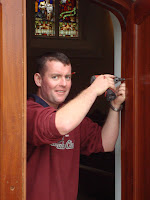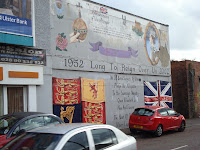 On our last day working in Ireland, John and I took the day off to spend the afternoon in Dublin (picture at left of the River Liffey at sunset). We took the city bus tour and made a few stops. It was supposed to be pouring rain all day. But when we got to downtown Dublin, the sun broke through the clouds and we had a great early afternoon with blue skies and nice fall temperatures. In fact, I was starting to re-think my choice of outerwear.
On our last day working in Ireland, John and I took the day off to spend the afternoon in Dublin (picture at left of the River Liffey at sunset). We took the city bus tour and made a few stops. It was supposed to be pouring rain all day. But when we got to downtown Dublin, the sun broke through the clouds and we had a great early afternoon with blue skies and nice fall temperatures. In fact, I was starting to re-think my choice of outerwear.We made a few stops along the way today. The first was at Trinity College to catch a glimpse of The Book of Kells a beautifully illustrated set of the Gospel created in the sixth century and on display in the library.
We walked from Trinity to Grafton Street which really set Dublin apart from our trip into Belfast. There were people everywhere and from all over. There were street musicians, singers and those "statue people" who stand frozen and scare little kids to death. Dublin is bigger and more cosmopolitan than Belfast. While Dublin has seen it's share of rebellion over the centuries, it doesn't have the remnants of the recent violence that Belfast has dealt with.
 Back on the tour bus, we stopped at the National Gallery before visiting Christchurch Cathedral (picture at left) for a quick stop before they held a late afternoon prayer service. We got to go down to the Crypt which was very interesting. There's a gold plate that was given to the cathedral by King William I (William the Orange) after winning the Battle of the Boyne.
Back on the tour bus, we stopped at the National Gallery before visiting Christchurch Cathedral (picture at left) for a quick stop before they held a late afternoon prayer service. We got to go down to the Crypt which was very interesting. There's a gold plate that was given to the cathedral by King William I (William the Orange) after winning the Battle of the Boyne.Both Christchurch and St. Patrick's, just down the street, are Protestant cathedrals. We thought it interesting that Dublin does not have a Catholic cathedral, at least according to the tour bus driver.
Because it was late in the afternoon and the rain had returned, we didn't get to stop at the Guinness Brewery or Jameson Distillery. John did some shopping and we went started back for Hillsborough. After dinner and some evening tea, we're back to pack and get ready for tomorrow. Pattie's flight gets in at 9am; and John flies out at about 11am. The three weeks went quickly as everyone said it would. We've met some really great people, seen some unbelievable sights and hopefully have shot enough interviews and video to produce an interesting television program.
I'll try to keep posting on our next week's activities as Pattie and I explore the south of the island. I'll let you know what the Missoula 12 are doing today. And I'll also give my best and worst moments of our production. Hope you'll keep checking back.
















































